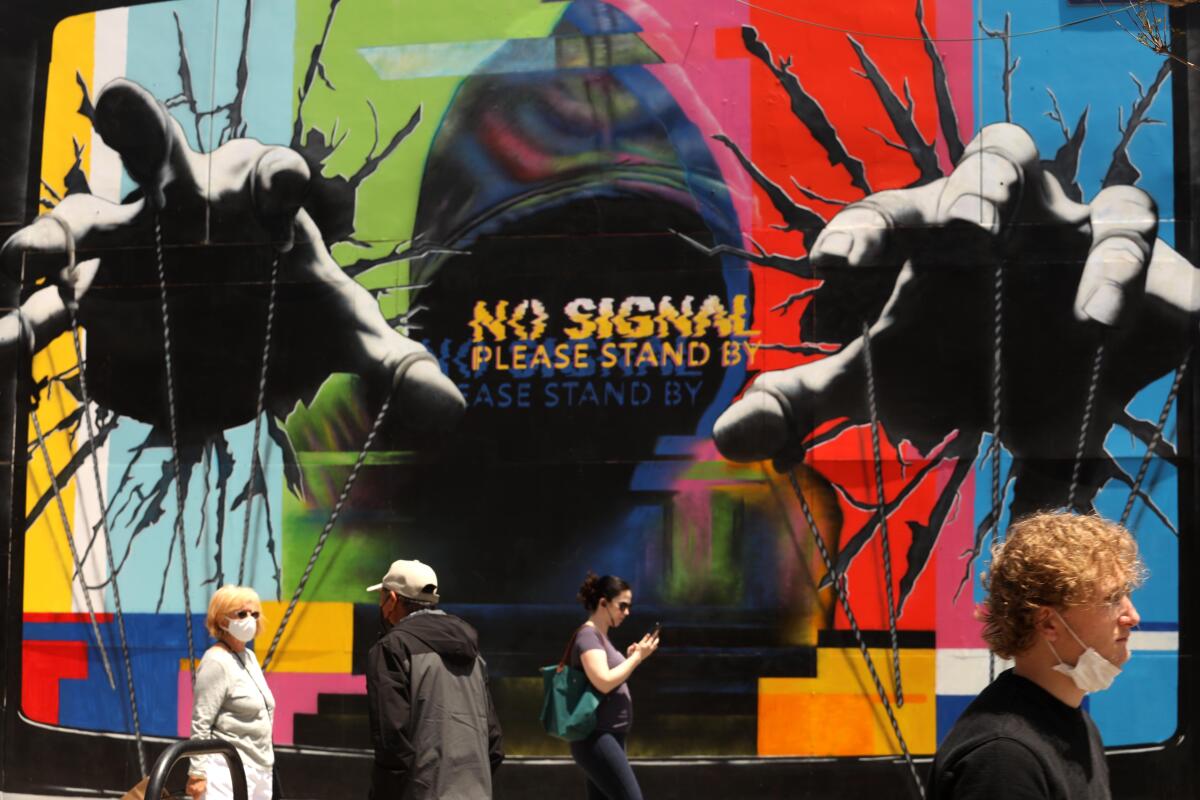Despite assurances, some don’t feel safe taking their masks off just yet

At Azteca Tortilleria in East Los Angeles, a sandwich board greets customers with a warning: “No mask, no service!”
The restaurant’s owner, Samantha Hernandez, has had to throw out angry people over the last year for refusing to wear one. But in recent months, most customers complied without much grumbling.
The announcement Thursday by the Centers for Disease Control and Prevention that suggested vaccinated people no longer needed to wear masks indoors took her aback — and put her in an awkward bind.
“Am I supposed to start asking people for vaccination cards now?” she asked. “It doesn’t make sense.... We’re not even up to 50% vaccinations.”
The CDC’s guidance caught many off guard in California, from local and state health officials to business owners and front-line workers. Opinion was largely divided: Some said the move felt premature and could hurt front-line workers. Others said it was about time, with California and many other states experiencing the lowest number of daily coronavirus cases in a year.
Dr. Anthony Fauci, director of the National Institute of Allergy and Infectious Diseases, told MSNBC that the CDC made the right call.
“You’re very safe, and that’s the reason why the CDC made that recommendation, because it became very clear that the infection rate has gone down.”
Fauci said the number of people who get infected after getting vaccinated is a “very, very, very small percentage.”
But the recommendation caught California officials by surprise, and many expressed doubt that the state is ready to adopt the mask guidance.
Gov. Gavin Newsom said the new CDC guidelines “have created some new anxiety for many: that it may be too soon, too much. And so we’re adjudicating all that.”
Barbara Ferrer, L.A. County’s public health director, was also not ready to implement the new approach immediately.
“We still have millions of people that are not vaccinated — that haven’t even gotten one dose,” Ferrer said Thursday. “And every day, the numbers may be small, but every day there are people who are getting infected.”
Many health experts, while not questioning the science behind the CDC’s move, wanted to see the case numbers remain low a bit longer before relaxing the mask rules.
“I’m surprised they came out with it this soon,” said Dr. John Swartzberg, a clinical professor emeritus of the UC Berkeley School of Public Health’s infectious diseases division. “I would’ve liked to have had another month under my belt of seeing the numbers continue to come down.”
Swartzberg said he preferred a view floated earlier this week by Newsom, who proposed two different ideas about how to ease mask mandates in California. His second idea, mentioned on Wednesday, suggested eliminating outdoor mask mandates next month but perhaps retaining indoor mask mandates for a bit longer.
“Instead of taking giant steps, like I think the CDC took, I think we should be taking small steps toward the same goal,” Swartzberg said. “We ultimately will get there. But I think we’ll get there more safely if we’re more cautious.”
The federal announcement raised questions about whether there would be any kind of enforcement. Would supermarkets be checking vaccination cards to see who could enter unmasked? Would health privacy laws even allow them to check?
“I can’t see grocery stores confirming that you’re vaccinated. It just won’t happen,” Swartzberg said.
The United Food and Commercial Workers union, which represents 1.3 million essential food and retail workers, criticized the announcement.
“While we all share the desire to return to a mask-free normal, today’s CDC guidance is confusing and fails to consider how it will impact essential workers who face frequent exposure to individuals who are not vaccinated and refuse to wear masks,” Marc Perrone, the union’s international president, said in a statement. “Essential workers are still forced to play mask police for shoppers.… Are they now supposed to become the vaccination police?”
Grocery stores could opt to simply retain a no-mask, no-service policy.
Already many companies have announced they have not changed their mask rules, including Home Depot, Target, Macy’s, Starbucks and Kroger, which operates Ralphs and Food 4 Less.
Costco and Walmart said they would drop the mask mandate in states where it is OK to do so.
Trader Joe’s also said it would allow fully vaccinated shoppers to be maskless inside its stores.
“We do not require proof of vaccination, as we trust our customers to follow CDC guidelines,” company spokeswoman Kenya Friend-Daniel said in an email.
Whether Trader Joe’s will implement that policy in California, where rules requiring masks remain in effect, is unclear. The company did not respond to a request for comment.
At least one Trader Joe’s location in L.A. County posted the company’s relaxed mask policy on Friday.
Of about 50 shoppers at Trader Joe’s South Pasadena location around 3:15 p.m. Friday, two were not wearing masks. Neither patron wished to comment to a reporter.
“This is irresponsible and too soon,” said Ana Mejia, 67, a Highland Park resident and vaccinated, masked shopper who stopped by for a bouquet of tulips and broccolini. “So many people are trying their best to stop this disease by masking and social distancing, and we’re not done.”
Mejia received two doses of the Moderna vaccine and worries about vulnerable people.
“There are still people trying to get shots, people who are vulnerable, and now you’re going to have people who haven’t taken a vaccination walking into the stores without masks,” Mejia said through her blue surgical mask. “There are a lot of liars.”
At a Smart & Final in Alhambra, shopper Benny Fong, 60, came masked and fully vaccinated for a sale on seedless watermelons and was ambivalent about the policy.
He said wearing the mask did not bother him, but added: “I think it should change soon.”
“It would be nice to stop using them, and I’m not afraid,” Fong said. “People are getting their shots and nobody likes wearing a mask.”
Shopping at the same store, San Gabriel resident Brenda Carlos, 32, said she feared that forgoing masks would cause the virus to ramp up again.
“How do we know if the person entering the store not wearing a mask is vaccinated or not?” she asked. “That seems like an easy way for the virus to spread.”
Carlos said she had been vaccinated but has immunocompromised friends unable to vaccinate and worries about their safety.
“There are people who have no symptoms who are carrying the virus and can spread it,” she said. “If they’re not wearing masks and not being honest, this could be dangerous.”
According to a Times analysis, half of California and L.A. County residents still have not received any COVID-19 vaccine dose, and some counties are far below the statewide rate.
San Bernardino County, for instance, has only 37% of its residents at least partially vaccinated, and Riverside County only 40%. In the San Joaquin Valley, Kern County has only 34% of its population at least partially vaccinated; in Kings County, it’s just 27%.
The CDC recommends that unvaccinated people still mask up, but that rests on good faith.
“It’s just that, from an implementation standpoint, we don’t quite trust that,” said UC San Francisco epidemiologist Dr. Kirsten Bibbins-Domingo.
She said that the new guidelines could pose a threat to people who want the vaccine but haven’t been able to get it for a variety of reasons.
For instance, a survey from the Kaiser Family Foundation shows that unvaccinated Latino adults are twice as likely as unvaccinated white adults to say they want a COVID-19 vaccine as soon as possible. But many Latino adults — particularly those who are poor, uninsured and possibly undocumented — express concerns about missing work due to vaccine side effects, about its cost (despite the shots being free), about finding a vaccination site they can trust, and finding transportation to the site.
“Those are all the barriers that are easy to overcome through concerted efforts to go put vaccines right away in their workplaces,” Bibbins-Domingo said.
Other experts thought the move was a good call, giving further motivation for people to get vaccinated.
“I know many on Twitter are saying the unvaccinated will simply say they were vaxed. Some will, but many won’t want to, they’ll now view vaccination as something with more value and seek it out,” tweeted Dr. Scott Gottlieb, former commissioner of the Food and Drug Administration.
Some experts who have urged the CDC to move faster to lift mask guidelines were surprised at how fast federal officials acted Thursday.
UC San Francisco infectious disease specialist Dr. Monica Gandhi said lifting mask guidance for fully vaccinated people will provide an incentive for those who may have put off getting the shot.
“People need incentives now,” Gandhi said. “I think this is going to help people who are on the fence to go and get vaccinated.”
Dr. Rochelle Walensky, the director of the CDC, has acknowledged that more details need to come out about how relaxing mask requirements indoors would realistically work in specific settings where it’s not clear who is vaccinated.
“This was a first step in our guidance. And what we really need to do now is look at each of our individual guidance for each of these individual settings in, say, in a setting of schools or child-care centers or the workplace — is this the appropriate thing to do?” Walensky said on ABC’s “Good Morning America” Friday.
Also, practically speaking, Walensky said it would make sense that different states and counties make different orders than the national guidelines.
“A lot of those decisions are going to have to happen at the jurisdictional level,” Walensky said.
Times staff writers Lila Seidman and Karen Kaplan contributed to this report.
More to Read
Sign up for Essential California
The most important California stories and recommendations in your inbox every morning.
You may occasionally receive promotional content from the Los Angeles Times.













